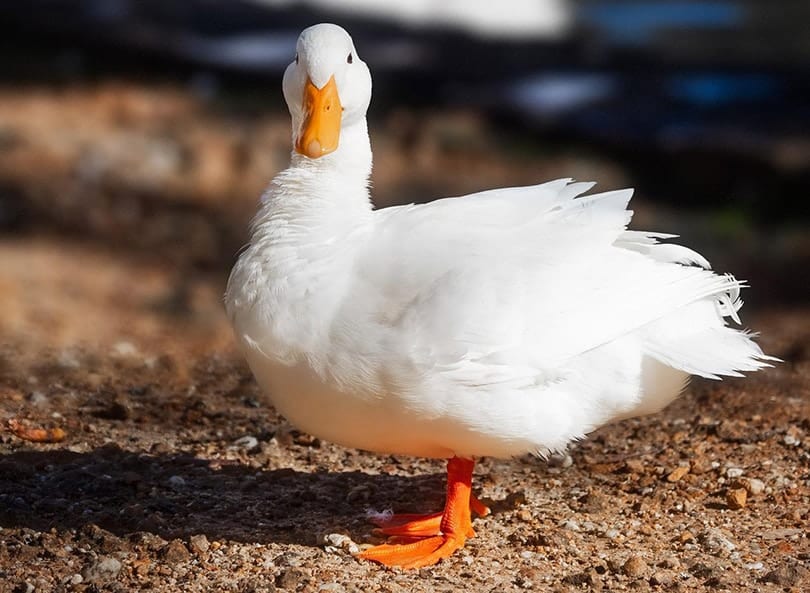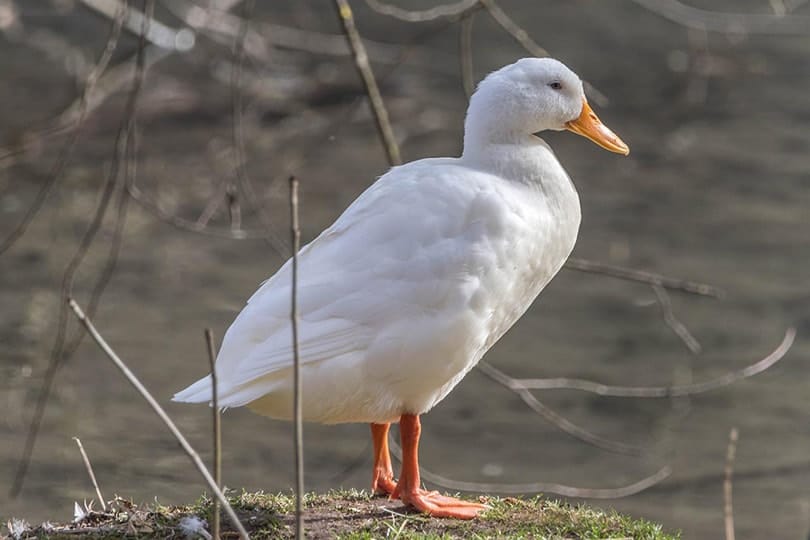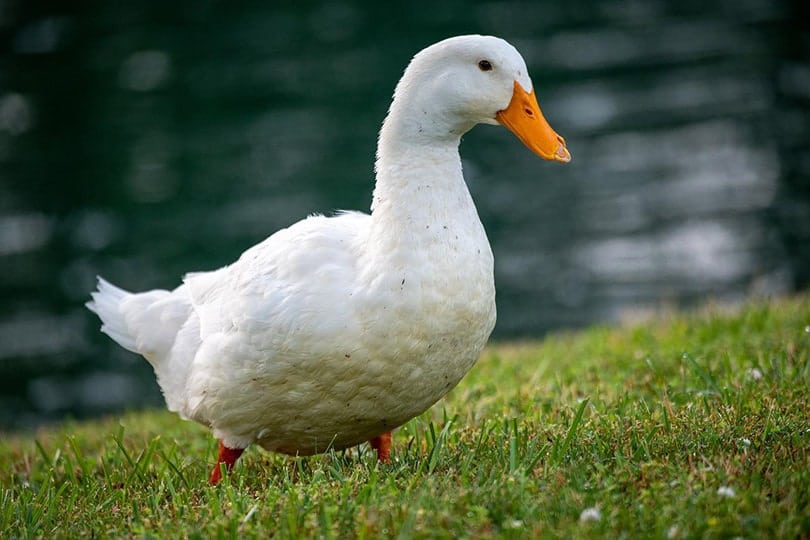The Pekin Duck, or American Pekin, is among the most popular duck breeds in the United States to be kept in homesteads or backyards. As a multi-purpose breed, these ducks are raised for both egg and meat production. Their affectionate and docile nature has led to many people keeping them as pets rather than livestock animals.

Quick Facts About Pekin Duck

| Breed Name: | American Pekin |
| Place of Origin: | China |
| Uses: | Eggs, meat, pet |
| Drake (Male) Size: | 9 lbs. |
| Hen (Female) Size: | 8 lbs. |
| Color: | White |
| Lifespan: | 8 to 12 years |
| Climate Tolerance: | Environmentally hardy, cold tolerant |
| Care Level: | Low to medium |
| Production: | Extra-large eggs, large meat volumes |
| Breeding: | Poor egg sitters require an incubator |
Pekin Duck Origins
Pekin ducks were first brought to the United States by James E. Palmer in 1872. The 15 birds were hatched in the Chinese city of Peking (modern Beijing) and journeyed 124 days to New York City. Only nine birds survived the voyage, and five were eaten before they reached their final destination. The remaining four ducks became the foundation stock for what we now know as the American Pekin Duck. By the summer of 1872, the three hens had laid over 300 eggs.
Other birds of the same type were imported to the United Kingdom in 1872, where they eventually reached Germany and gave rise to the German Pekin. This is a distinct and separate breed from the American Pekin, with different physical characteristics.

Pekin Duck Characteristics
Pekin Ducks are known to be non-aggressive, friendly birds. They are becoming more popular as farm pets for this reason, as they are willing to accept their handlers petting them. Ducks that are handled frequently from the time of hatching will easily become accustomed to human touch and handling, while that’s more difficult for older birds to accept. The Pekin’s favorite activity around humans is to lay upside down in someone’s lap while having their belly gently stroked.
This duck breed is excellent at free-ranging. They are capable of foraging for the majority of their diet while remaining on alert for potential predators and rushing back to their coop for safety as needed.
Hens are known for being quite noisy, especially when spoiled as pets. They are easily trained to human routines, so hens that are used to being fed at a certain are sure to honk loudly if you are late.
While Pekin hens are attentive mothers and excellent egg layers, they are terrible egg-sitters. If you intend to breed Pekin ducks, placing the eggs in an incubator is highly recommended until the chicks hatch. After this point, their mother is happy to take over and teach her ducklings how to behave and forage independently.
Uses
This duck breed is raised almost exclusively for meat, with over half of the ducks raised for slaughter in the United States coming from this breed. This is due to their fast growth rate and high feed conversion ratio. White-feathered ducks are also easier to pluck and clean from the carcass.
Pekin ducks are being raised for eggs in increasing numbers. On average, hens lay 200 to 300 extra-large eggs per year and will typically begin laying at 5 to 6 months of age. They require 8 to 10 hours of light per day to lay, so they will need a coop light to lay during the winter months.
If you’re more accustomed to collecting eggs from chickens, ducks lay their eggs a little differently. Unlike chickens, which lay on individualized 26-hour schedules, ducks always lay eggs at night, sometime between dusk and dawn. This routine makes it easier to collect duck eggs on a regular schedule.
That collecting schedule is incredibly important because ducks will not lay their eggs inside a nest. They almost exclusively drop their eggs anywhere and everywhere they feel like. Occasionally, a hen may lay an egg and roll it into her nest if she feels like it.

Appearance & Varieties
The American Pekin is a solidly built, large-sized duck that is exclusively white. Their body is rectangular shaped and sits about 40 degrees above horizontal. This duck’s breast does not show a pronounced keel but is broad and smooth. The head of a Pekin is creamy white, while their legs and feet are yellowish orange. They have a yellow beak that is short and almost perfectly straight.
Population/Distribution/Habitat
Pekin ducks are a domesticated duck breed that loves to spend their time outdoors, even during the cold winter months. Unlike chickens, which prefer to hide inside the coop once the snow falls, Pekins can often be found frolicking around all winter long.
Even so, they require a warm coop to spend the night in or to retreat to during stormy weather. While ducks love to be out in the rain, they will hide during thunderstorms.
Ducks require access to a small swimming pool or pond to be truly happy, and they should never be without access to water for more than 8 hours.
The number of Pekin ducks in the United States is in the tens of millions.

Are Pekin Ducks Good for Small-Scale Farming?
Pekin ducks are a good choice for pets or poultry animals on small-scale farms. They will happily co-exist with chickens in a coop or roam the farm free-range. If they are permitted to be free-range, they will forage for most of their food.
As a supplement or during the winter months, ducks can be fed poultry or chicken feed, but they will receive more protein from game bird feed. Chick starter feed is suitable for young ducklings. Since duck beaks are built a little differently than other poultry animals like chickens or turkeys, they will benefit from a pelleted or crumble feed rather than scratch, which they find difficult to pick up.

Final Thoughts
Pekin ducks are an American duck breed that can be raised for both eggs and meat. Their friendly and trainable nature makes them popular farm pets. If raised from a hatchling, they can easily become used to being handled by humans. These ducks are hardy and tolerant of cold climates. If allowed to roam free, they will obtain most of their diet from forage, making them easy ducks to keep.
Featured Image Credit: woeger, Pixabay
